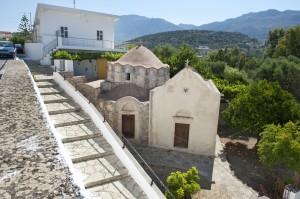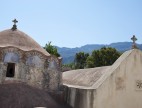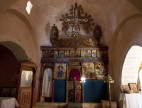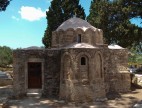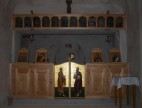Holy Apostles at Kato Episkopi
The church of the Holy Apostles on the western boundaries of the small settlement of Kato [Lower] Episkopi, where the seat of the Diocese of Siteia may have been transferred during the second Byzantine period, is a tripartite building with a dome. The central, larger space is covered by an octagonal dome, which rests on alternating arches and rudimentary squinches, while the narrower spaces, east and west, are covered by a semi-circular barrel-vault. In the middle of the long sides are five-sided conches with blind arcades. The masonry is covered by off-white mortar with incisions that imitate opus pseudo-isodomum. The arches are built with the recessed brick technique. The ceramoplastic decoration consists of quatrefoil ceramic rosettes that surround the arches and bricks that were positioned to form a cross or sunrays. The building was originally a bath, similar in form to the corresponding one in Episkopi of Ierapetra, as was discovered during the recent restoration work. During the 15th century, the bath with small modifications was converted into the church of the Holy Apostles. The original entrance of the bath opened in the west wall and led to the changing area and perhaps to the “cold room” (frigidarium). The central space, where the embedded underfloor ducts are located and from which the hot air came, was the ‘hot house’ (caldarium) of the bath. The side conches, where there were built seats, appear to have been used as individual bathtubs. The eastern annex, in the lower section of which were found an arched opening and traces of fire, was probably the cistern and the heating area for the water. The architectural elements, which can be connected to the tradition of Constantinople, lead to the dating of the monument to the 11th century. The existence of crosses on the external surfaces in conjunction with the fact that the settlement was the seat of the diocese lead to the suggestion that the existence of the bath is connected to the bishop’s palace as also happened in the corresponding case of Ierapetra where it was built opposite the cathedral church.

